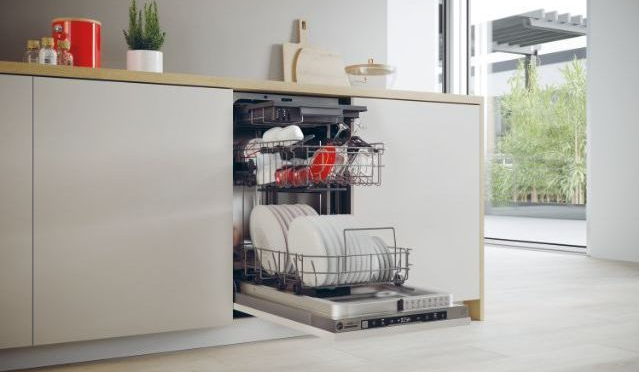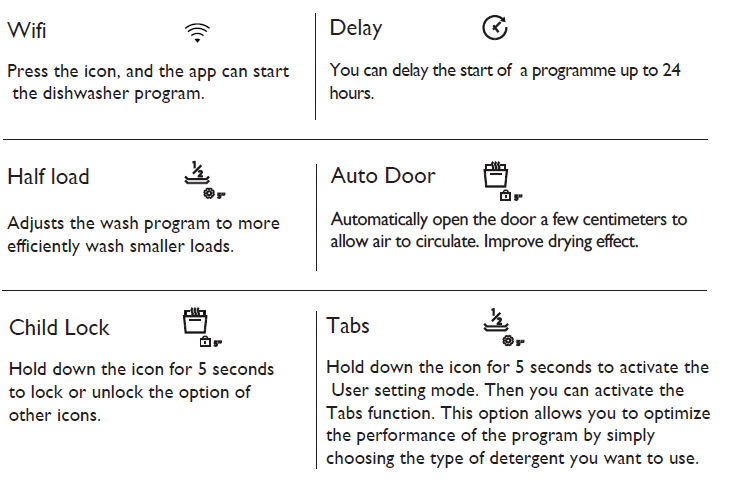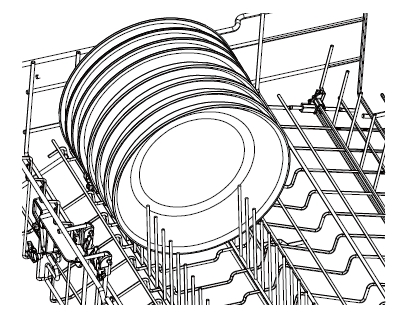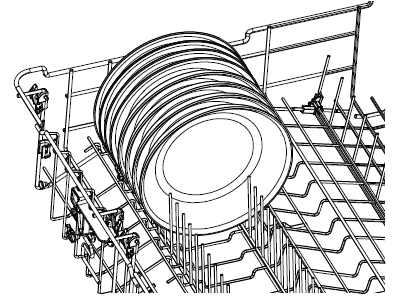
Hoover 32901787 Dishwasher
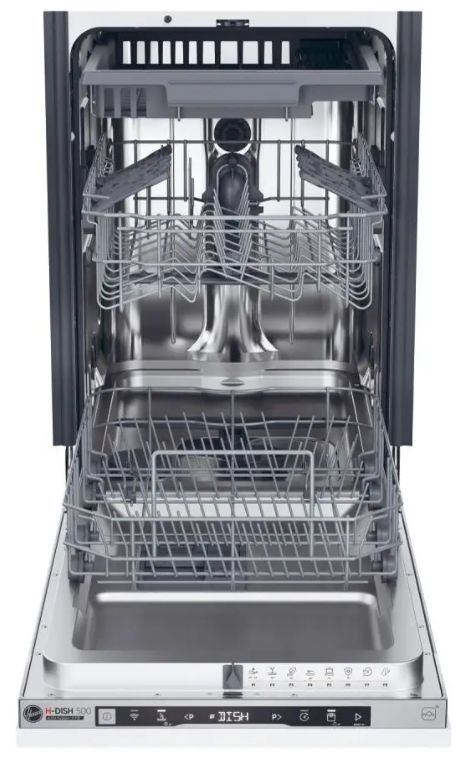
Safety and Warnings
Intended Use
The appliance is designed for domestic use inside the house, or in similar applications such as staff kitchen areas in working environments, farmhouses, by clients in hotels, motels, or other residential environments, and bed and breakfast environments. It is not intended for commercial or industrial use. Do not use it for purposes other than those for which it was designed. Changes or modifications to the device are not allowed. Unintended use may cause hazards and loss of warranty claims.
Standards and Directives
This product meets the requirements of all applicable EC directives with the corresponding harmonised standards, which provide for CE marking.
Read and Save This Guide
When using your dishwasher, follow basic precautions, including the following:
General
- The information in this guide must be followed to minimise the risk of fire or explosion to prevent property damage, personal injury, or loss of life. Use the dishwasher only for its intended function as described in this guide.
- This appliance is intended to be used in household and similar applications such as:
- Staff kitchen areas in shops, offices, and other working environments
- Farmhouses
- By clients in hotels, motels, and other residential environments
- Bed and breakfast environments
- Use only detergents or rinse aid recommended for use in a domestic dishwasher, and keep them out of reach of children. Check that the detergent dispenser is empty after the completion of each wash program.
- When loading items to be washed, locate sharp items so that they are not likely to damage the dishwasher, and load sharp knives with the handle up to reduce the risk of cut injuries.
- Do not touch the filter plate in the dishwasher base during or immediately after use, as it may be hot.
- Do not operate your dishwasher unless all enclosure panels are properly in place.
- Do not tamper with the controls.
- Do not abuse, sit on, stand in, or sit on the door or dish rack of the dishwasher.
- The door should not be left in the open position since this could present a tripping hazard.
- The foldaway cup racks are designed to support cups, glasses, and kitchen utensils. Do not lean on or use the foldaway cup racks to support your body weight.
- To reduce the risk of injury, do not allow children to play in or on the dishwasher.
- Under certain conditions, hydrogen gas may be produced in a hot water heater system that has not been used for two weeks or more. HYDROGEN GAS IS EXPLOSIVE. If the hot water system has not been used for such a period, before using the dishwasher, turn on all hot water taps and let the water flow from each for several minutes. This will release any accumulated hydrogen gas. As the gas is flammable, do not smoke or use an open flame during this time.
- Remove the door to the washing compartment when removing an old dishwasher from service or discarding it.
- Some dishwasher detergents are strongly alkaline. They can be extremely dangerous if swallowed. Avoid contact with the skin and eyes, and keep children away from the dishwasher when the door is open.
- The dishwasher must be used with the filter plate, filter, and spray arms in place. To identify what these parts are, refer to ‘Maintenance’.
- If the dishwasher is not being used for long periods of time, turn the electricity and water supply off.
- Cleaning and maintenance shall not be done by children without supervision.
- Take care not to load dishware items so they do not prevent the door from closing.
- Household appliances are not intended to be used by children. Children of less than 8 years old must be kept away from the appliance unless continuously supervised. This appliance can be used by children aged 8 years and above, and persons with reduced physical, sensory, or mental capabilities or lack of experience and knowledge, if they have been given supervision or instruction concerning the use of the appliance in a safe way, and they understand the hazards involved. Children are supervised not to play with the appliance.
- If a dishwasher cleaner is used, we recommend running a wash program with detergent immediately afterward to prevent any damage.
- The dishwasher is designed for washing normal household utensils. Items that are contaminated by petrol, paint, steel, iron debris, corrosive, acidic, or alkaline chemicals are not to be washed in the dishwasher.
- Do not wash plastic items unless they are marked dishwasher safe or equivalent. For plastic items not marked, check the manufacturer’s recommendations.
- Avoid washing containers with glued-on labels. Labels removed during a wash cycle may cause damage to the wash system.
Installation
- This dishwasher must be installed and located in accordance with the installation instructions before it is used. If you did not receive installation instructions with your dishwasher, you can order them by calling your authorised repairer or download them from our local Haier website, listed on the back cover.
- Installation and service must be performed by a Haier-trained and supported service technician.
- If the power supply cord is damaged, it must be replaced by a Haier-trained and supported service technician or a qualified tradesperson in order to avoid a hazard.
- Ensure the dishwasher is secured to adjacent cabinetry using the brackets provided. Failure to do so may result in an unstable product, which may cause damage or injury.
- Do not operate this appliance if it is damaged, malfunctioning, partially disassembled, or has missing or broken parts, including a damaged power supply cord or plug.
- Do not store or use petrol or other flammable vapours and liquids in the vicinity of the dishwasher.
- Connect to a properly rated, protected, and sized power supply circuit to avoid electrical overload.
- Ensure the power supply cord is located so that it will not be stepped on, tripped over, or otherwise subject to damage or stress.
- Do not install or store the dishwasher where it will be exposed to temperatures below freezing or exposed to weather.
- Do not use an extension cord or a portable electrical outlet device (e.g., multi-socket outlet box) to connect the dishwasher to the power supply.
- This appliance must be grounded. In the event of a malfunction or breakdown, grounding will reduce the risk of electric shock by providing a path of least resistance for electric current.
- This appliance is equipped with a cord having an equipment-grounding conductor and a grounding plug. The plug must be plugged into an appropriate outlet that is installed and grounded in accordance with all local codes and ordinances. Improper connection of the equipment-grounding conductor can result in a risk of electric shock. Check with a qualified electrician or Haier-trained and supported service technician if you are in doubt as to whether the appliance is properly grounded.
- Do not modify the plug provided with the appliance; if it will not fit the outlet, contact a Haier-trained and supported service technician or qualified electrician.
- If the dishwasher is installed as a permanently connected appliance, this appliance must be connected to a grounded metal, permanent wiring system, or an equipment-grounding conductor must be run with the circuit conductors and connected to the equipment-grounding terminal or lead on the appliance.
Maintenance
- Disconnect the appliance from the power supply before any cleaning or maintenance.
- When disconnecting the appliance, pull the plug rather than the power supply cord or junction of the cord to avoid damage.
- Do not repair or replace any part of the appliance or attempt any servicing unless specifically recommended in this guide. We recommend contacting a Haier-trained and supported service technician or Customer Care.
- Keep the floor around your appliance clean and dry to reduce the possibility of slipping.
- Keep the area around/underneath your appliance free from the accumulation of combustible materials such as lint, paper, rags, and chemicals.
Product Description
- Ensure the installer has completed the ‘Final checklist’ in the installation instructions.
- Read this guide, taking special note of the ‘Safety and warnings’ section.
- Remove all internal and external packaging and dispose of it responsibly. Recycle items that you can.
Dishwasher Overview
- Middle spray arm
- Lower spray arm
- Filter
- Rinse aid dispenser
- Detergent dispenser
- Rating label
- Cutlery/Utensil tray
- Lower basket
- Upper basket
- Third basket

Models with 11 place settings have only the third basket.
Control Panel
- ON/OFF icon
- WiFi indicator icon
- Half load indicator icon
- Programme select icon
- Time & Info display/indicator icon
- Delay indicator icon
- Auto Door indicator icon
- START/RESET icon

Time & Info Display
During any selection, the display shows related information like
- programme cycle time,
- programme start delay time
- error codes.
After the start of an operation, it displays without flashing:
- Remaining time in hours of a delayed programme start, e.g.

- Remaining programme cycle time in hours + minutes, e.g.

- While running, it may vary due to local conditions and daily working load.
Indicator Icon

Optional function.
The main program matched with the optional function.
Programme
Your dishwasher has a number of wash programs designed to suit your needs. Selecting the most appropriate cycle for each load will help ensure the best wash results.
- The appliance senses the type of soil and the quantity of items in the baskets. It automatically adjusts the temperature and quantity of water, energy consumption, and programme duration.
- Use this programme to quickly rinse the dishes. This prevents the remaining food from bonding to the dishes and bad odours coming out from the appliance. Do not use detergent with this programme.
First Use
Dishware
The combination of high temperatures and dishwasher detergent may cause damage to some items. Refer to the manufacturer’s guidance or wash by hand if in doubt.
Cutlery & Silverware
Rinse cutlery and silverware immediately after use to prevent tarnishing. Silver should not come into contact with stainless steel, as mixing these can cause staining. Remove silver cutlery from the dishwasher and hand-dry immediately.
Aluminium
Aluminium can be dulled by detergent. The degree of change depends on the quality of the detergent or aluminium.
Other Metals
Iron and cast iron can rust and stain other items. Copper, pewter, and brass tend to stain.
Woodware
Woodware is generally sensitive to heat and water. Regular use in the dishwasher may cause deterioration over time.
Glassware
Most glassware is dishwasher safe. Crystal, very fine and antique glassware, may etch and develop a cloudy appearance.
Plastics
Some plastics may change shape or colour with hot water. Refer to the manufacturer’s guide. Dishwasher-safe plastic should be weighed down so it does not flip and fill with water or fall through the base rack during the wash.
Decorated Items
Most modern china patterns are dishwasher safe. Antique items, those with a pattern painted over the glaze, gold rims, or hand-painted china, may be more sensitive to machine washing.
Glued Items
Certain adhesives are softened or dissolved in machine washing.
Water Hardness
Hard water is water with a high concentration of minerals such as calcium and magnesium. It can be detrimental to the performance of your dishwasher, and parts can fail over time. Glassware washed in hard water will become cloudy over time, and dishes will become spotted or covered in a white film. Water hardness varies by geographical location. If you live in a hard water area, we recommend fitting a water softener to the household water supply.
If your home has hard water:
- Refer to ‘Powdered detergent quantity recommendations’.
- Use rinse aid. We recommend you raise the rinse aid setting to help improve wash performance. Refer to ‘Preferences’ for details.
- Use a dishwasher cleaner/descaler regularly, or whenever you notice a build-up of limescale deposits in your dishwasher.
If your home has soft or softened water:
- Avoid using too much detergent.
Loading Suggestions
When loading your dishwasher, ensure items are placed so that water coming from the rotating spray arm below can reach all areas. Wash performance will be reduced if it can’t. Your dishwasher can hold up to a maximum of 11 place settings.
Ensure:
- Lower and middle spray arms can rotate freely.
- Tall items do not obstruct the upper spray arm.
- Glass and other fragile items are stable.
- All dish openings are facing downwards.
- Plates are evenly spaced.
- All sharp objects are securely located to avoid injury or damage to the product.

Avoid:
- Overcrowding.
- Any protrusions below the racks and the basket that may prevent spray arm rotation.
- Any protrusions at the front of the dishwasher.
- Blocking water from any items on the foldaway cup racks.

Setting a Wash
- Remove all food scraps from dishware before carefully loading it into the dishwasher. Ensure the spray arms are free from any obstructions and rotate freely.

- If the rinse aid indicator is illuminated, fill the rinse aid dispenser. Refer to ‘Rinse Aid’ for additional guidance.

- Add detergent to the dispenser and close the cover. Tablets can be placed in the detergent dispenser.

- Make sure the dishwasher is powered on press the
 .
.
- Select a wash modifier if required.

- Press
 to start the wash and close the door.
to start the wash and close the door.
- Open the door slowly at any point during the wash to pause. Press and hold
 for 3 seconds to cancel.
for 3 seconds to cancel.
- After washing, the door will automatically open slightly to assist with drying. For best results, unload dishes once cooled. This function can be activated or not by the user.

Delayed Start
Set your dishwasher to start later in the day and run a selected wash program. DELAYED START can be set after a wash program has been selected and can be set for up to 24 hours.
Setting Delayed Start:
- Add detergent and select a wash program, and wash modifier if required. Press
 to enter DELAYED START and increase the delay time. For the 0–4 hours, increase or decrease by 30 minutes each press, and for 4–24 hours, increase or decrease by 1h.
to enter DELAYED START and increase the delay time. For the 0–4 hours, increase or decrease by 30 minutes each press, and for 4–24 hours, increase or decrease by 1h.
- Press
 to confirm and promptly close the door. The wash program will begin at the end of the countdown, provided the door is closed.
to confirm and promptly close the door. The wash program will begin at the end of the countdown, provided the door is closed.
- Open the door to pause DELAYED START. Close the door to continue.
Cancelling Delayed Start:
- Open the door and press and hold
 for 3 seconds to cancel.
for 3 seconds to cancel.
Keylock
Lock the dishwasher controls for cleaning or to prevent unintended use.
Locking the Controls
- Press and hold
 for 5 seconds to lock the dishwasher controls. Note: Before locking the controls, run the program. After locking, except for the unlocking and turn-off operation, other functions are not available.
for 5 seconds to lock the dishwasher controls. Note: Before locking the controls, run the program. After locking, except for the unlocking and turn-off operation, other functions are not available.
Unlocking the controls
- Press
 and hold for 5 seconds to unlock.
and hold for 5 seconds to unlock.
Water Softening System
Using Special Salt
As soon as the low salt indicator is lit on the control panel, salt should be topped up. Always refill with special salt immediately before switching on the appliance. This ensures that the overrun special salt solution is immediately washed out and does not corrode the rinsing tank.
Top up the salt as follows:
CAUTION: Only use dishwasher salt. Other products can cause damage to the appliance! Any spilled salt causes corrosion. Run a programme after each refill.
- Turn the cap clockwise to open the salt container.
- Fill with 1 litre of water into the salt container.
- Fill the tank up with specific salt (water overflows).
- Remove spilled salt from the opening area.
- Turn the cap counterclockwise to close the salt container.

Rinse Aid
Rinse aid provides a streak-free finish to glass and dishware, as well as preventing metal from tarnishing. We recommend using a liquid rinse aid regularly for optimal drying results. The rinse aid dispenser is located on the inside of the door next to the detergent dispenser.
Using Rinse Aid
The amount of rinse aid dispensed in each wash may need to be adjusted to suit your water conditions. Refer to ‘Preferences’ and ‘Water Hardness’ for guidance. Rinse aid is not required if the tablet already has it built in.
- When the rinse aid level is low, the rinse aid indicator on the control panel will light up to remind you to refill the dispenser.

- Lift the cover open and pour rinse aid into the opening. Do not fill past the MAX line. Take care not to spill any onto the door or detergent bucket.

- Close the cover, ensuring it clicks shut.

Any accidental spillages into the dishwasher or detergent bucket must be cleaned up immediately. Spilt rinse aid may result in excessive foaming. A service call relating to these will not be covered under warranty.
Daily Use
Load the Baskets:
![]() With delicate glasses and porcelain, make sure they are labelled dishwasher-proof.
With delicate glasses and porcelain, make sure they are labelled dishwasher-proof.
- Do not put in the appliance items made of wood, horn, aluminium, pewter, or copper.
- Do not put in the appliance items that can absorb water (sponges, household cloths).
- Only use the appliance to wash items that are dishwasher-safe.
- Remove remaining food from the items.
- Soften burned food on the items before washing.
- Put hollow items (cups, glasses, and pans) with the opening down.
- Put items with deep hollows in a slanted position.
- Mix spoons with other cutlery to prevent them from bonding together.
- Make sure that cutlery and dishes do not bond together, and there is a gap between each item.
- Make sure that glasses do not touch other glasses.
- Put small items in the cutlery basket.
- Put light items in the upper basket. Make sure that the items do not move.
- Make sure that the spray arms can move freely before you start a programme.
![]() If jingling noises are heard during a programme run, check that the dishes and glassware have a firm position. Place heavily soiled items (like pots and pans or dinner plates) in the bottom basket. The more powerful spray jet provides a better dishwashing result.
If jingling noises are heard during a programme run, check that the dishes and glassware have a firm position. Place heavily soiled items (like pots and pans or dinner plates) in the bottom basket. The more powerful spray jet provides a better dishwashing result.
Troubleshooting






For more details, visit www.hoover.com
For More Manuals By Hoover, Visit ManualsLibraryy.
Hoover 32901787 Dishwasher-FAQs
Q1. How do I clean the Hoover dishwasher filter?
Remove the bottom rack, take out the filter, rinse it under warm water, and scrub gently with a soft brush to clear food particles. Ensure it’s fully dry before reinserting.
Q2. Why is my Hoover dishwasher not working?
Check if there’s power to the socket, a blown fuse, or a power cut. Make sure the door is properly closed, as the dishwasher won’t run if the safety lock isn’t engaged.
Q3. How do I start a Hoover dishwasher?
Press and hold the Programme Selection button while switching on the appliance with the On/Off button. A short beep will confirm it’s ready.
Q4. How do I unlock my Hoover dishwasher?
Press and hold the Cycle button (or Dry Boost + Steam buttons, depending on model) for about 3 seconds until the lock light turns off.
Q5. Why is my Hoover dishwasher not draining water?
A clogged filter, blocked drain hose, or faulty drain valve may be the cause. Clean the filter and check the drain connections to restore proper flow.
Q6. What does error code E2 mean on a Hoover dishwasher?
Error code E2 usually points to a temperature sensor (NTC) fault. Contact Hoover support if the error persists after a reset.
Q7. Do Hoover dishwashers have a quick wash option?
Yes, most models include a quick wash cycle that cleans lightly soiled dishes in 30–60 minutes for faster results.
Q8. How do I reset my Hoover dishwasher?
Turn the dishwasher off and unplug it for about one minute (or switch off the circuit breaker if hardwired). Then power it back on to reset the system.
Q9. Why is my Hoover dishwasher stopping mid-cycle?
This usually happens when the appliance cannot drain water properly. Check for standing water in the base and clean the pump filter if needed.

